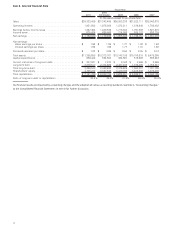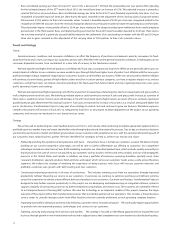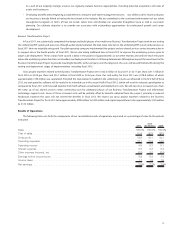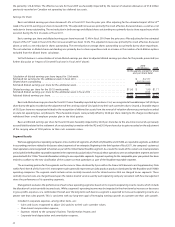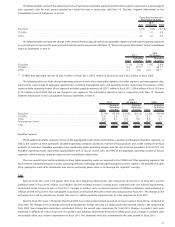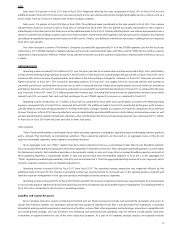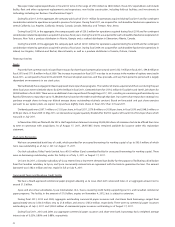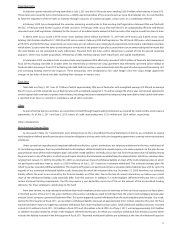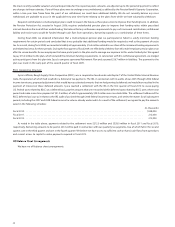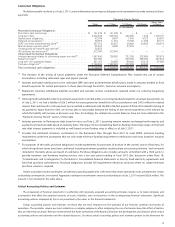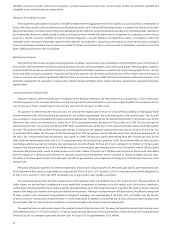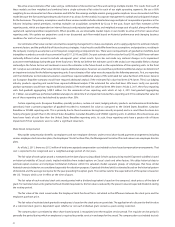Sysco 2011 Annual Report Download - page 46
Download and view the complete annual report
Please find page 46 of the 2011 Sysco annual report below. You can navigate through the pages in the report by either clicking on the pages listed below, or by using the keyword search tool below to find specific information within the annual report.
Operating Income
Operating income increased by 0.1% in fiscal 2011 over fiscal 2010 as gross profit dollars increased slightly above the rate that operating
expenses increased. However, it is important to note that operating expenses included a significant charge of $36.1 million from a withdrawal
from a multi-employer pension plan. Additionally, negatively affecting the operating income comparison of fiscal 2011 to fiscal 2010 was the
additional week in fiscal 2010.
Gross profit dollars increased in fiscal 2011 primarily due to increased sales; however, gross profit dollars increased at a lower rate than sales.
This slower growth in gross profit dollars was primarily the result of two factors. Based on Broadline’s product sales mix for fiscal 2011, it was most
impacted by higher levels of inflation in the dairy, meat and seafood product categories in the range of 10% to 12%. Broadline’s largest selling
product category, canned and dry, experienced inflation of 4%. While we are generally able to pass through modest levels of inflation to our
customers, we were unable pass through fully these higher levels of product cost inflation with the same gross profit percentage in these product
categories without negatively impacting our customers’ business and therefore our business. While we cannot predict whether inflation will
continue at these levels, prolonged periods of high inflation, either overall or in certain product categories, can have a negative impact on our
customers, as high food costs can reduce consumer spending in the food-away-from-home market, and may negatively impact the Broadline
segment’s sales, gross profit and earnings. Second, ongoing strategic pricing initiatives largely lowered our prices to our customers in certain
product categories in order to increase sales volumes. These initiatives are being phased in over time and resulted in short-term gross profit
declines as a percentage of sales, but we believe will result in long-term gross profit dollar growth due to higher sales volumes and increased
market share. We have experienced meaningful year over year volume growth with those items included in the early phases of these programs in
the geographies where this program has been implemented. We believe the long-term benefits of these strategic initiatives will result in profitable
market share growth.
In addition, gross profit dollars for fiscal 2011 increased as a result of higher fuel surcharges. Fuel surcharges were approximately $19.4 million
higher in fiscal 2011 than the prior year due to the application of fuel surcharges to a broader customer base for a small portion of the third quarter
and the entire fourth quarter due to higher fuel prices incurred during these periods. Assuming that fuel prices do not greatly rise above recent
levels during fiscal 2012, we expect fuel surcharges to largely offset our increased fuel costs expected in fiscal 2012.
The expense increases in fiscal 2011 were driven largely by provisions for withdrawal from a multi-employer pension plan and an increase in
pay-related expenses. In fiscal 2011, we recorded provisions of $41.5 million for withdrawal liabilities from multi-employer pension plans from
which union members elected to withdraw. The increase in pay-related expenses related to the sales and gross profit increase, including both
delivery personnel costs and sales. Portions of our pay-related expense are variable in nature and are expected to increase when sales and gross
profit increase. Pay-related expenses from acquired companies and changes in the exchange rates used to translate our foreign sales into
U.S. dollars also contributed to the increase.
Fuel costs were $22.0 million higher in fiscal 2011 than the prior year. Assuming that fuel prices do not rise significantly over recent levels
during fiscal 2012, fuel costs for fiscal 2012 not including any amounts recovered through fuel surcharges, are expected to increase by
approximately $25 million to $35 million as compared to fiscal 2011. Our estimate is based upon current, published quarterly market price
projections for diesel, the cost committed to in our forward fuel purchase agreements currently in place for fiscal 2012 and estimates of fuel
consumption. Actual fuel costs could vary from our estimates if any of these assumptions change, in particular if future fuel prices vary significantly
from our current estimates. We continue to evaluate all opportunities to offset potential increases in fuel expense, including the use of fuel
surcharges and overall expense management.
Operating income increased by 5.9% in fiscal 2010 over fiscal 2009 primarily due to effective management of operations in the current
economic environment by decreasing expenses as compared to the comparable prior year periods. Operating expenses decreased 1.2% in fiscal
2010 as compared to fiscal 2009. The additional week in fiscal 2010 contributed to the gross profit increase, partially offset by a decrease of
approximately $37.4 million in the fuel surcharges charged to customers in fiscal 2010 as compared to fiscal 2009 due to less usage of these
surcharges in fiscal 2010. Expense performance for fiscal 2010 was primarily due to reduced fuel cost and lower provision for losses on receivables
and operating efficiencies, such as reduced pay — related expense due to reduced headcount. Fuel costs were $51.8 million lower in fiscal 2010
than in the prior year. Partially offsetting these expense declines were increases in expenses related to the additional week in fiscal 2010.
From time to time, we may voluntarily withdraw from multi-employer pension plans to minimize or limit our future exposure to these plans.
We recorded provisions related to multi-employer pension plans of $41.5 million in fiscal 2011, $2.9 million in fiscal 2010 and $9.6 million in fiscal
2009.
SYGMA Segment
SYGMA operating companies distribute a full line of food products and a wide variety of non-food products to certain chain restaurant
customer locations. SYGMA operations have traditionally had lower operating income as a percentage of sales than Sysco’s other segments. This
segment of the foodservice industry has generally been characterized by lower overall operating margins as the volume that these customers
command allows them to negotiate for reduced margins. These operations service chain restaurants through contractual agreements that are
typically structured on a fee per case delivered basis.
22


